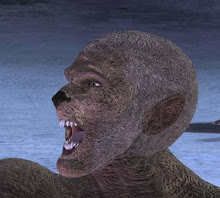History Channel - Original Air Date: 10/28/09
When I started the review for this show, I did not realize that it was the show that Linda Godfrey and I had done some filming for last year -- on our Uncanny Radio show. So, in full disclosure, we're in it, and you can hear Linda on the radio, and our guest Steve Kreuger is featured. (Though he was not a Bray Road witness, as the show claimed.) Having said that, we're a minor piece of the program -- blink and you'll miss me -- and I'll try to review the show objectively.
This show looks at the 1740s "werewolf" attacks in southern France known as The Beast or "La Bete." (Also the subject of the Brotherhood of the Wolf movie and the first Dark Angel novel.) Over the course of a few years, about 100 people -- mostly women and children -- were brutally attacked and killed. Was it a human killer, a mystery animal, a werewolf, or something else? A profiler, George "Duke" Deuchar, and a cryptozoologist, Ken Gerhard, set out ot find out. To bring viewers up to date, the show talks about werewolf history, the history of the attacks, and even manwolf in the US. (I'm operating the radio control board during the interview with Steve Kreuger; blink and you'll miss me, though there's a good shot of Linda.) As the team investigates in France, the profiler, Duke, becomes suspicious that the alleged "animal" bypassed easy prey in favor of humans. The cryptozoologist, Ken, remains convinced that the beast could have been some unknown or prehistoric animal. He shows the Duke some Texas chupacabra footage to make his point about strange animals existing even today. (The coyote-wolf hybrid footage.) The two examine caves in France where the beast may have hidden, and also a print alleged to be from the beast -- it's many times the size of a normal wolf. Some reports from the time point at a wild, hairy human -- or near human -- as the culprit. Talking to the local police, Duke concludes that the information of the time is filled with rumor and superstition, and the witnesses were unreliable.
Historically, the king sent soldiers to sort the situation out, but they didn't solve the problem -- the attacks continued, despite military presence. Meanwhile, Ken is inputting data based on old drawings into a computer (not a brilliant forensic technique, since we have no reason to believe the artists ever saw the creature), and concludes that a hyena may be the suspect. He notes that some reports even had the creature "laughing" -- which Duke points out seems to indicate a human even more. Ken points out that some people believe that they become animals, and some people with genetic mutations even look like wolfmen. A French historian believes that the attacks were not done by humans, but the team remains skeptical. Duke suggests that the beast may have been a wolf trained to kill by a human serial killer, but wolf experts say wolves cannot be trained that way -- though a large dog could. Science, however, suggests that dogs cannot decapitate people the way the beast did. Three years after the attacks began, a farmer armed with a blessed silver bullet shot the beast through the heart, and the attacks stopped for good. The team talks with the farmer's descendant, and finds the scene where the beast was slain. The animal's body was taken to Versailles, to show the king, and then apparently disposed of. As Ken looks for it, Duke asks about the farmer -- who may have been an outcast before he became a hero. A historian suggests that everything about the beast legend may have been exaggerated by the church, for their own benefit.
Meanwhile, it turns out that the beast may have been on exhibit at a French museum -- and the animal was listed by the museum as a long-haired striped hyena. (It's not clear where the specimine is now -- though its bones may have been used to repair other display specimens.) A hyena's bite force and attack pattern seem to match the beast, and a zoologist says a hyena could be trained to attack. The museum curator says that local royalty often kept exotic animals. Could the farmer have owned it, only to kill it for the reward? Back in the States, Duke tries to find out if a silver bullet could have killed a hyena in one shot. The test shows that silver bullets, which are harder than lead, are less accurate; they do not deform because of barrel rifling. (But were 1740s guns rifled? The show doesn't say - but a quck check shows that rifling did not become common until the 19th century -- 50 to 100 years after the attacks. An obvious flaw in the show's scientific technique.) Silver bullets also cause less tissue damage than a standard lead bullet (because they don't deform). Because of these challenges, Duke thinks the farmer set the whole thing up; he could kill the beast easily, because he owned it. The show concludes that it was a man-beast team that caused the legend of the beast -- and bolstered the werewolf legend. In some sense, the killer was a man-wolf.
This was a good show. The history is well laid out and interesting, and the through-story compelling. I'm not sure I agree with their conclusions, though their theory does (mostly) fit the facts, and their investigation techniques are passable. People interested in The Beast (La Bete) or werewolf legends should find this show a good place to start. (Don't look for Linda and me in the credits -- though WBSD made it.)
Saturday, October 31, 2009
Subscribe to:
Post Comments (Atom)





No comments:
Post a Comment